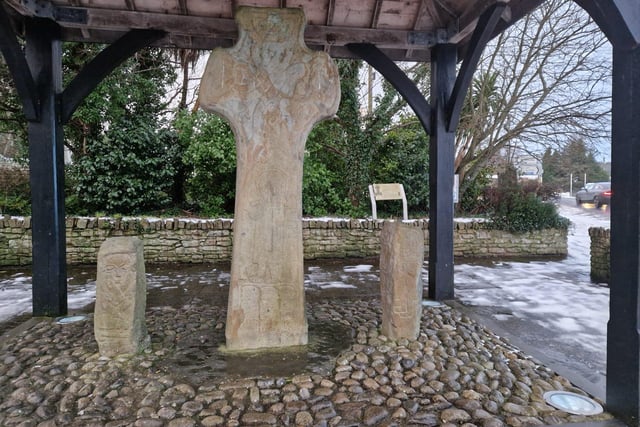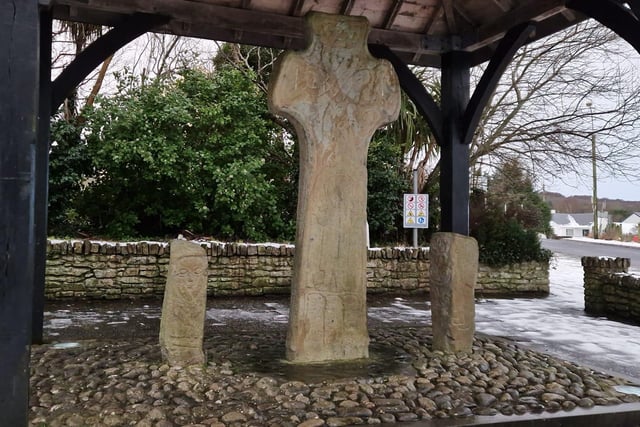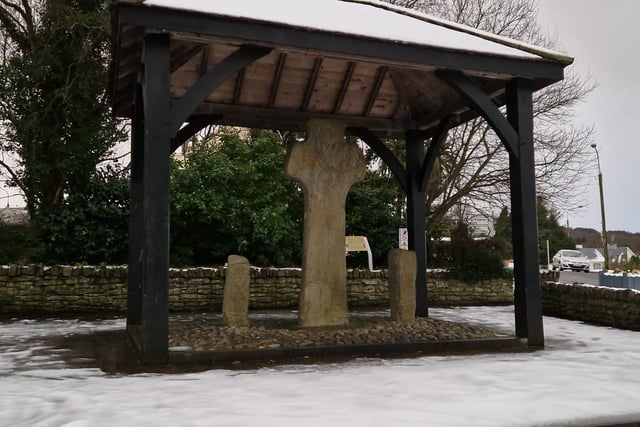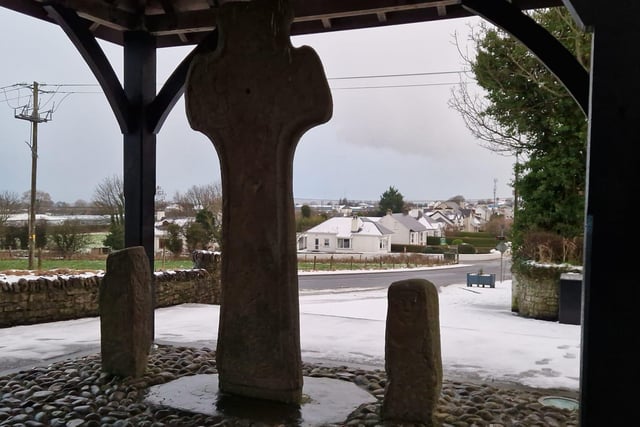For centuries the cross has been a place of pilgrimage and provides a window into the past of this beautiful market town which was once a major seat of ecclesiastical learning and the site of an early monastery.
The striking national treasure is free to visit and is located to the west of the town near the junction with the roads to Buncrana and Ballyliffin.
The high cross is made of standstone and features an elaborate interlacing knot design, unqiue among all the the ancient crosses still in existence in Ireland, and a carving of Christ crucified as well as other figures which may possibly represent the apostles or early Irish saints or holy people. There is also a depiction of women at Jesus’ tomb, possibly including Mary Magdalene. There are also animals depicted including birds and fish.
Two intriguing smaller slab pillars accompany it on either side, one featuring King David and another person, possibly a religious person in high office in Ireland, and depicting what may be the earliest Irish harp ever etched. The other pillar is carved with a strange animalic figure and the elaborate artwork of the three structures in similar in style to the Celtic artworks and manuscripts.
In his book, Ancient monuments of Inishowen, north Donegal, Seán Beattie describes how such Pillar Stones are sometimes referred to as guard stones and may have been used as boundary markers as well as in a protective capacity for a cross or monastic site.
The graveyard just behind the cross also contains an ancient stone slap carved with a marigold pattern and various crosses.
The Inishowen peninsula – which boasts Ireland’s most northerly point at Malin Head – is extremely rich in early Christian and pre-Christian sites, with further early Christian crosses at St Mura’s graveyard in Fahan, Carrowmore and Bocan. The are numerous prehistoric cairn, court and wedge tombs dotting the landscape as well as ancient ring forts, castles and standing stones all within a short distance of the Carndonagh Cross.
If you are in the area why not check out the Druids Altar (Temple of Deen) and Bocan Stone circle near Culdaff, the cup marks rock art on the Isle of Doagh, the huge Grianán of Aileach ring fort to the south of the peninsula, the early Cross Slab of St Mura in Fahan, the Cooley Cross and skull house in Moville, the soaring Cloncha Cross and ancient church site beside it and the historic Iskaheen chapel in Muff.
Inishowen is also home to many other stunning sites many of which are, like thos ementioned above, only a short distance from Derry and from each other. These include Carrickabraghy castle on the Isle of Doagh, the romantic Inch castle ruins on Inch Island, the towering Northburg Castle ruins at Greencastle, O’Doherty’s Keep at Swan Park in Buncrana, Burt Castle and the Wee House of Malin at Malin Head. Some of the sites are on private land so you may need to ask first, but many others can be visited freely and are easily accessible just off the road network.


2. Carndonagh Cross in Donegal (6).jpeg
The 7th Century Carndonagh Cross in Donegal. Photo: Brendan McDaid


4. Carndonagh Cross in Donegal (2).jpeg
The 7th Century Carndonagh Cross in Donegal. Photo: Brendan McDaid